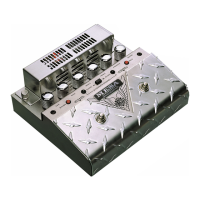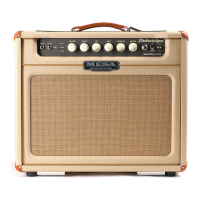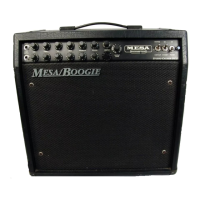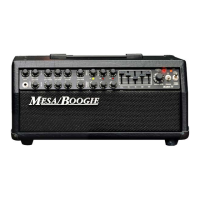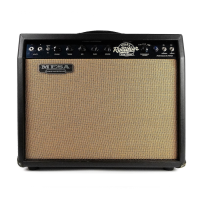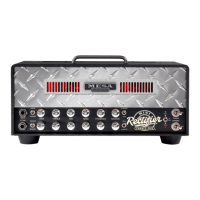FRONT PANEL: Controls & Features
(Continued)
control is responsible for the blend of midrange frequencies in the mix and though its effect is not as dramatic as
that of the TREBLE control, it plays an integral part in achieving any sound in your
It is capable of changing the
feel dramatically as it blends in a group of frequencies that tend to soften or stiffen the way a sound feels to play.
Most players tend to lean in the direction of lower
control settings (7:00 - 11:00) where a scoop in this region produces
letting the Bass become a little more dominant) and a lack of punch lends a more compressed,
feel to the strings and therefore
even feel to the strings and therefore even
less apparent resistance to the pick. As the
control is increased, (11:30 - 1:30)
the sound is rounded-out and fi lled-in with a focused mid attack appearing rather
quickly. As you would guess, the feel starts to change - becoming more resistant.
control could be used to compensate for either weaker
pick-ups or for times when a specifi c defi ciency is produced by either an extremely
high setting of other tone controls, or a physical anomaly in the room. While these
control settings (2:00 - 5:00) can introduce added gain and create enhanced
focus, the trade-off will be a stiffer, more forward, less compressed feel.
works similarly in both channels in that it determines the amount of low
frequencies present in a sound. However, the
it mixes in changes from channel to channel. Like the MID control, it falls
style of lows it mixes in changes from channel to channel. Like the MID control, it falls style of lows
the TREBLE control and the same scheme applies. When the TREBLE control is set high, the effectiveness
after the TREBLE control and the same scheme applies. When the TREBLE control is set high, the effectiveness after
of the BASS and MID controls is reduced. If the TREBLE control is set low these two controls
For the most balanced sound and a balance of power between the three rotary tone controls,
try to use the TREBLE control in its middle ranges. This scenario produces nearly equal repre-
sentation of all the frequencies on the tone controls and provides a great neutral starting point
control in both channels of your
though we have taken steps to ensure a balanced tone is easy to achieve, it is wise to blend
with subtle nuance in mind. This is especially true in Channel 2 when using either the regular Channel 1 style gain circuitry cranked,
or the DRIVE circuitry for higher gain lead sounds. A good rule to follow is this; as you increase the GAIN reduce the BASS. Following
this scheme will retain balance and keep the attack of the notes dynamic, tight and touch sensitive.
control is a high frequency attentuator that is placed at the end of each channels pre-amp stage
and affects frequencies higher than those of the TREBLE control. It acts independently of the other rotary tone controls and is crucial
in voicing the Channel. It is a powerful global tone control. Lower
control settings darken and, in fact compress the signal
which works well to fatten single note solo sounds, giving them girth and focus.
Some of the best lead sounds in your
control in it’s lower regions, where a balanced, vocal response is achieved.
CH 1
FT SW
CH 2
THICK
THICKER
CLEAN
MAL
GAIN MID
TREBLE
NOR

